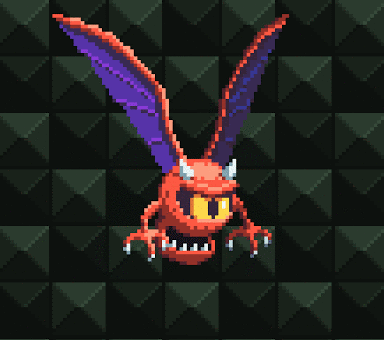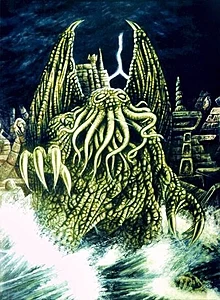In mythology, the Greek underworld is an otherworld where souls go after death. The original Greek idea of afterlife is that, at the moment of death, the soul is separated from the corpse, taking on the shape of the former person, and is transported to the entrance of the underworld. The underworld itself—sometimes known as Hades, after its patron god—is described as being either at the outer bounds of the ocean or beneath the depths or ends of the earth. It is considered the dark counterpart to the brightness of Mount Olympus with the kingdom of the dead corresponding to the kingdom of the gods. Hades is a realm invisible to the living, made solely for the dead.

Chupacabras
Chupacabras can be literally translated as "goat-sucker", from chupar ("to suck") and cabra ("goat"). It is known as both chupacabras and chupacabra throughout the Americas, with the former being the original word, and the latter a regularization of it. The name is attributed to Puerto Rican comedian Silverio Pérez, who coined the label in 1995 while commenting on the attacks as a San Juan radio deejay.
History
The first reported attack eventually attributed to the creatures occurred in March 1995 in Puerto Rico. Eight sheep were discovered dead, each with three puncture wounds in the chest area and reportedly completely drained of blood. A few months later, in August, an eyewitness, Madelyne Tolentino, reported seeing the creature in the Puerto Rican town of Canóvanas, when as many as 150 farm animals and pets were reportedly killed. In 1975, similar killings in the small town of Moca were attributed to El Vampiro de Moca ("The Vampire of Moca"). Initially, it was suspected that the killings were committed by a Satanic cult; later more killings were reported around the island, and many farms reported loss of animal life. Each of the animals was reported to have had its body bled dry through a series of small circular incisions.
Puerto Rican comedian and entrepreneur Silverio Pérez is credited with coining the term chupacabras soon after the first incidents were reported in the press. Shortly after the first reported incidents in Puerto Rico, other animal deaths were reported in other countries, such as the Dominican Republic, Argentina, Bolivia, Chile, Colombia, Honduras, El Salvador, Nicaragua, Panama, Peru, Brazil, United States, and Mexico.
In October and December 2018, there came many reports of chupacabras suspects in Manipur, India. Many domestic animals and poultry were killed in a suspicious manner as chupacabra does. Many people said that they had seen the species (chupacabras) with their eyes. However, forensic experts opined that there was no any aspect of chupacabra but street dogs were responsible for mass killing of domestic animals and poultries after studying the remnant of corpse. In 19 July 2019,this creature sighted in Karachi (Pakistan) {Karachi traders fearful after ‘mysterious creature’ sighted in Shershah}.
Reputed origin
A five-year investigation by Benjamin Radford, documented in his 2011 book Tracking the Chupacabra, concluded that the description given by the original eyewitness in Puerto Rico, Madelyne Tolentino, was based on the creature Sil in the 1995 science-fiction horror film Species. The alien creature Sil is nearly identical to Tolentino’s chupacabra eyewitness account and she had seen the movie before her report: "It was a creature that looked like the chupacabra, with spines on its back and all... The resemblance to the chupacabra was really impressive," Tolentino reported. Radford revealed that Tolentino "believed that the creatures and events she saw in Species were happening in reality in Puerto Rico at the time," and therefore concludes that "the most important chupacabra description cannot be trusted." This, Radford believes, seriously undermines the credibility of the chupacabra as a real animal.
In addition, the reports of blood-sucking by the chupacabra were never confirmed by a necropsy, the only way to conclude that the animal was drained of blood. An analysis by a veterinarian of 300 reported victims of the chupacabra found that they had not been bled dry.
Radford divided the chupacabra reports into two categories: the reports from Puerto Rico and Latin America where animals were attacked and it is supposed their blood was extracted, and the reports in the United States of mammals, mostly dogs and coyotes with mange, that people call "chupacabra" due to their unusual appearance.
In late October 2010, University of Michigan biologist Barry O'Connor concluded that all the chupacabra reports in the United States were simply coyotes infected with the parasite Sarcoptes scabiei, whose symptoms would explain most of the features of the chupacabra: they would be left with little fur, thickened skin, and rank odor. O'Connor theorized that the attacks on goats occurred "because these animals are greatly weakened, they're going to have a hard time hunting. So they may be forced into attacking livestock because it's easier than running down a rabbit or a deer."
Although several witnesses came to the conclusion that the attacks could not be the work of dogs or coyotes because they had not eaten the victim, this conclusion is incorrect.Both dogs and coyotes can kill and not consume the prey, either because they are inexperienced, or due to injury or difficulty in killing the prey. The prey can survive the attack and die afterwards from internal bleeding or circulatory shock.The presence of two holes in the neck, corresponding with the canine teeth, are to be expected since this is the only way that most land carnivores have to catch their prey.
There are reports of stray Mexican Hairless Dogs being mistaken for chupacabras.
Appearance
The most common description of the chupacabra is that of a reptile-like creature, said to have leathery or scaly greenish-gray skin and sharp spines or quills running down its back. It is said to be approximately 3 to 4 feet (0.9 to 1.2 m) high, and stands and hops in a fashion similar to that of a kangaroo.
Another common description of the chupacabra is of a strange breed of wild dog. This form is mostly hairless and has a pronounced spinal ridge, unusually pronounced eye sockets, fangs, and claws. Unlike conventional predators, the chupacabra is said to drain all of the animal's blood (and sometimes organs) usually through three holes in the shape of a downwards-pointing triangle or through one or two holes.
Related legends
"Grunches", a favored legend that gets its name from a road in between the Mississippi river and the Gulf of Mexico, known as lovers lane, to the locals of New Orleans.
The "Ozark Howler" a large cougar like animal.
The Peuchens of Chile also share similarities in their supposed habits, but instead of being dog-like they are described as winged snakes. This legend may have originated from the vampire bat, an animal endemic to the region.
In the Philippines, another legendary creature called the Sigbin shares many of chupacabra's descriptions.
In popular culture
The popularity of the chupacabra has resulted in its being featured in many types of media.
Following the incident in Cuero, Texas, the popularity of the chupacabra myth was receiving global attention. Phylis Canion, who was responsible for capturing the alleged specimen, claimed that T-shirts highlighting the event were shipped to locations such as Italy, Guam, and Iraq. The publicity that Cuero received following this event has led to some suggesting changing the town's mascot.
The myth of the chupacabra is mocked in the 2012 episode "Jewpacabra" of the cartoon series South Park in which antisemitic main character Eric Cartman claims to have seen a Jewish Chupacabra that kills children on Easter.
The Magic: The Gathering set Rivals of Ixalan introduced a card named Ravenous Chupacabra in January 2018.
In 2018, the Chupacabra was included as one of several vinyl figurines in Cryptozoic Entertainment's Cryptkins blind box toy line.
The search for a chupacabra was featured in the 1997 The X-Files episode "El Mundo Gira"
"Chupacabra" was the title of the midseason finale of season 4 of the supernatural drama television Grimm in December 2014.

Cthulhu
Cthulhu is a fictional cosmic entity created by writer H. P. Lovecraft and first introduced in the short story "The Call of Cthulhu",[2] published in the American pulp magazine Weird Tales in 1928. Considered a Great Old One within the pantheon of Lovecraftian cosmic entities, the creature has since been featured in numerous popular culture references. Lovecraft depicts Cthulhu as a gigantic entity worshipped by cultists. Cthulhu's appearance is described as looking like an octopus, a dragon, and a caricature of human form. Its name was given to the Lovecraft-inspired universe where it and its fellow entities existed, the Cthulhu Mythos..





